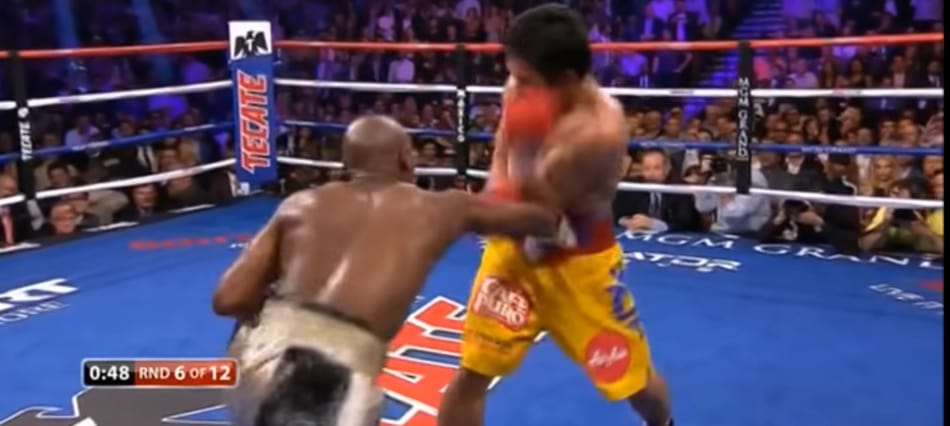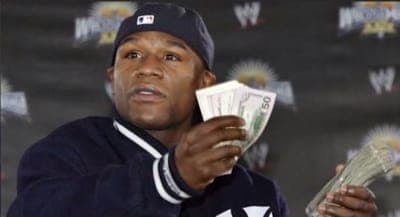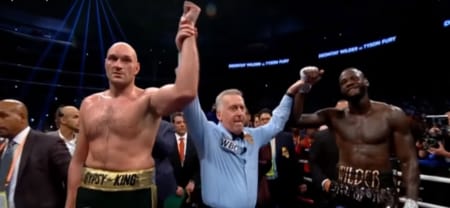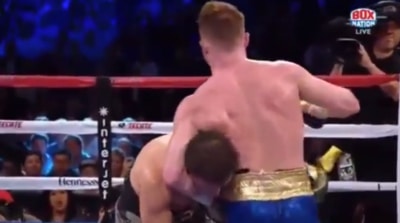
Boxing involves a lot of punches per match, and sometimes a match will erupt in a flurry of blows. Punch quantity differs based on boxing styles and weight classes.
But how many punches on average do boxers throw in a fight? In a boxing match, slower measured fights between heavyweights tend to come in at 30 punches a round or less, while faster, fights in the lower weight classes can contain as many as a 100 punches per round. Given the average between the two extremes of the spectrum and multiplying it by a twelve-round bout, you’ve got an average of 780 punches thrown between two people at an average of 65 punches per round.
Of course, this is just an average data from all weight classes and different types of fights/fighters. The stats can vary a lot depending on those factors. For example, if you check the statistics of a one-punch knockout artist like, for instance, Deontay Wilder you will notice that he isn’t throwing so many punches compared to other heavyweights.
That’s because he isn’t trying to win on points or out-box his opponent. He knows that he can put the other boxer away with just one clean shot, so he just waits for the perfect opportunity and tries not to waste too much energy or expose himself.
Boxers like him don’t need to throw many punches to knock their opponent out, while other fighters, for example, Tyson Fury who doesn’t have that one-punch knockout power throws much more punches and his finishes are due to accumulative damage rather than power.
Read on to find out more about the different number of punches thrown in fights by different types of boxers.
Power punches vs Jabs
The jab is the most important punch in boxing. It’s usually the least powerful punch you can throw but boxers don’t use it to cause damage. They use the jab to measure the distance for their power hand, to set up combinations to keep a distance or to mask movement. That’s why the jab is also the most used punch in boxing. There are boxers who would throw 2 times more jabs then power punches (hooks, rear hand straight punches, and uppercuts).
But there are boxers who don’t jab that often. For example, southpaws use their left hand more often than their jab because it has an open path to their opponents’ faces while the jab can be easily parried by the left hand of the other boxer. Also, counter punchers don’t jab so often. They usually wait for you to throw so they can avoid the punch by slipping, parrying, etc and then land a counter blow.
So those two types of boxers (plus the one-punch knockout artists) usually throw fewer punches on average compared to their opponents just because they aren’t jabbing so often.
Landed punches vs Thrown punches
780 is a huge number of punches. But this is a number of thrown punches, not landed punches. The percentage of your accuracy can vary a lot depending on the defensive skills of your opponent and his distance management. For example, when Manny Pacquiao fought Floyd Mayweather, who is a defensive genius, his accuracy (the percentage landed punches vs thrown punches) was only 19% (81 landed out of 429 thrown) while when he fought Margarito (who looked like a punching bag that night) his accuracy was 44% (landed 474 out of 1069).
Average Punches Thrown Depends on the Weight Class
The average number of punches thrown in a fight also depends heavily on the weight class of the boxer whose punch count is being tallied. Heavier weight classes tend to throw fewer punches on average during a match than lower weight classes.
They have the most powerful punches amongst all people but they are bigger, slower and their gas tanks aren’t as good as the lighter weight classes. That’s why we notice fewer punches thrown in the heavyweight bouts. But don’t forget that just one of those punches can be enough to close the show the heavyweight class has more knockouts than any other weight class.
On the other hand, the speed, agility, technique, and cardio of the lighter weight classes correlate to the higher volume of punches they throw. Usually the lower the weight class is, the more punches boxers throw.
To compensate for a lack of mass, smaller fighters such as multi-weight champion Manny Pacquiao are more likely to use lightning fast combos rather than waiting for an opening. This hesitation can leave a lighter boxer open to devastating blows. To see Pacquiao’s moves in action, check out this video:
Fast vs Slow fights
There are two main reasons that cause slow fights – boxers are hesitant to engage for some reason (waiting for their opponent to attack first so they can counter; they think they are ahead on the scorecards so they just stall), or there is a lot of clinching that also stalls the action.
Slower fights are usually viewed as boring and most of the casual fans don’t enjoy them so much. In such fights, the number of punches thrown isn’t that big. On the other end of the spectrum are the slugfests where the fighters exchange punches trying to knock each other out. In such fights the number of thrown punches is enormous – there are some examples of such fights below.
Number of Punches Thrown in Some of Boxing’s Greatest Matches
Since there are so many different weight classes and many different subtle variations of strategy in boxing, the number of punches thrown varies wildly from boxer to boxer. Below are some of the greatest boxing matches in recent history and the number of punches thrown by each of the competitors:
Orlando Salido vs. Francisco Vargas, June 2016
The match between these two incredible warriors ended at a draw after a grueling twelve rounds, but not until over two thousand blows were exchanged between them.
In the match, Salido threw a total of 939 punches and managed to land 328 of them for a 34.9% landed punch rate. Vargas threw 1184 punches and managed to land 386 of them for a 32.6% landed punch rate. The two boxers fought so ferociously that the officials had no choice but to declare the match a tie.
Anthony Joshua vs. Wladimir Klitschko, April 2017
Joshua and Klitschko went almost as long as Salido and Vargas, running each other down by varying between wary circling and Klitschko pummeling Joshua until the 11th round when Joshua managed to flatten Klitschko in a technical knockout and become the new heavyweight champion. This London showdown led to Klitschko’s consequent retirement from boxing just a few months later.
In the match, Joshua threw 355 punches and managed to land 107 of them for a 30.1% landed punch rate. Klitschko threw 256 punches and managed to land 94 of them for a 36.7% landed punch rate. These two fighters were well-respected for their humility prior to the match, and after his victory, Joshua confirmed that he’d be happy to give Klitschko another go any time.
Arturo “Thunder” Gatti vs. Micky “Irish” Ward, May 2002
“Irish” Mickey Ward and “Thunder” Arturo Gatti went to battle at the Mohegan Sun Casino in Uncasville, and nobody watching expected the ninth round to be one of the most epic rounds of boxing in recent history.
This match was widely considered the fight of the year for 2002, despite the fact that neither boxer was known for their technical skills. However, their ability to take a punch and keep coming with seriously heavy hits in return made for a dramatic bout, and while they remained strong rivals, the two fighters also ended up becoming friends over the courses of their respective careers until Gatti’s death in 2007.
In the match, Gatti threw 779 punches and managed to land 350 of them for a 45% landed punch rate. Ward threw 550 punches and managed to land 268 of them for a 49% landed punch rate. The victory was awarded to Ward by narrow decision.
Kostya Tszyu vs. Ricky “Hitman” Hatton, June 2005
This grueling match between Tszyu and Hatton was held in Manchester, England, and lasted for eleven brutal rounds.
This was a bout based on endurance, and Hatton ultimately took the day, with Tszyu conceding the match from his stool in total exhaustion by the 11th round. Getting Tszyu to this point was no easy task considering he was ranked as the second-best welterweight fighter in the world per pound at the time.
In the match, Tszyu threw 473 punches and managed to land 200 of them for a 39% landed punch rate. Hatton threw 836 punches and managed to land 225 of them for a 24% landed punch rate.
Israel Vasquez vs. Rafael Marquez, March 2008
By March 2008, Vasquez and Marquez had already done battle twice, developing a fierce rivalry that culminated in their match at the Home Depot Center in Carson, California. Marquez took the early lead in the bout, but Vazquez started winding up as the fight progressed.
The two fought into the eleventh and twelfth rounds, with Vasquez battering Marquez viciously at every turn without giving him much of a chance to retaliate. While the referee was on the verge of calling the match in the 11th round due to the ferocious beating that Marquez was taking, Marquez wouldn’t allow it, and the fight continued into the final round.
In the match, Vasquez threw an average of 148 punches per round and landed 46, while Marquez threw an average of 60 punches per round and landed 31. Vasquez was declared the winner by split decision, which was a decision widely contested within the boxing community.
The pair only had one other fight in May 2010, after which Vasquez retired at the age of 38 after having his right eye removed after being repeatedly damaged in the ring by his previous bouts.
Final Thoughts
Analyzing the fights above, you can see that it doesn’t really matter how many punches a boxer throws, or even how many he lands. Hatton won against Tszyu despite having a lower landed punch rate, and Vasquez won against Marquez despite the fact that Marquez injured Vasquez so badly in the fight that it eventually led to the loss of his eye.
Ultimately, regardless of how many punches a boxer takes over the course of his career, the victory is going to go to the boxer with the best punching strategy for their particular skill set. That means heavy punchers leaning into their power at the expense of speed, and lighter fighters like Pacquiao turning into a veritable whirlwind behind the ropes.
It just goes to show you how intricate of a sport boxing is that both tactics are equally likely to result in a resounding victory in the ring.



